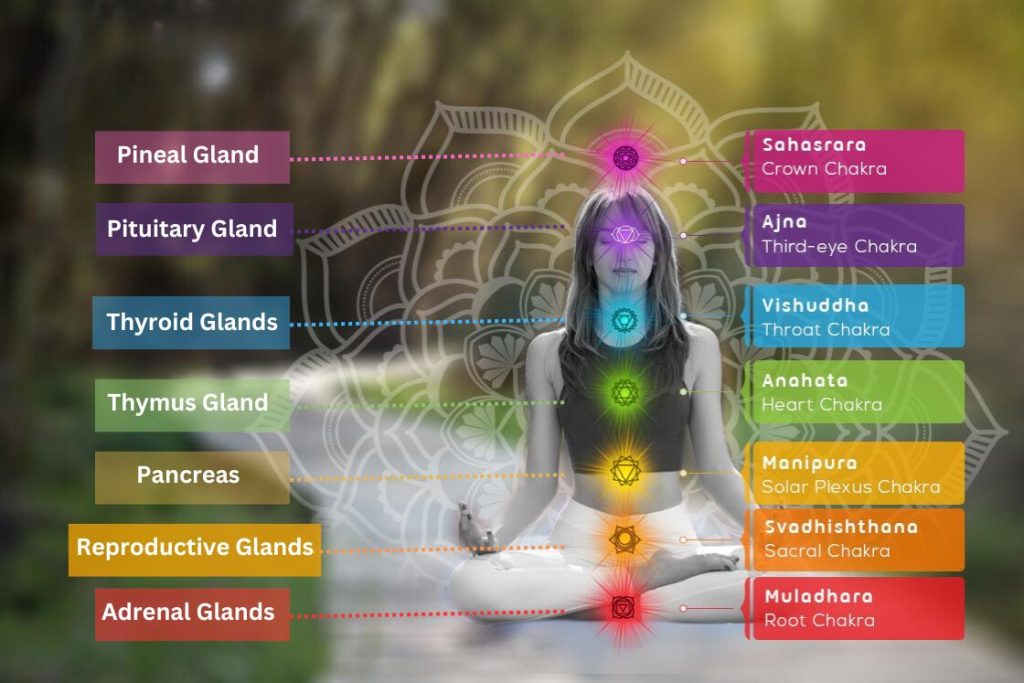
Most Yoga and Ayurveda literature, techniques, and cures have been built around the 7 main chakra systems in our subtle body. These chakras are said to be aligned with various Nadis, however, in the physical body, they are linked with the endocrine and nervous systems.
Understanding the relationship and dependency the chakras have on the endocrine system and vice versa is an important aspect to maintain overall health and well-being.
In this article, we will understand how the chakras and the endocrine are correlated and why it is important to maintain health at both energetic and physical levels to attain optimum health.
Understanding the Chakras
The chakras are a spinning ball of energy centers that support the flow of prana in the physical and subtle body. The word comes from Sanskrit meaning wheel or circle, and it is mentioned in various Hindu and Buddhist texts. While Buddhists believe that there are 4 main chakras, Hinduism believes that there are 7 main chakras out of about 114 chakra systems in our body.
According to the Yogic and Ayurvedic traditions, these 7 chakras are located along the spine, from the base of the spine to the crown of the head.
The 7 chakras, from the base to the crown of the head, are
- Root Chakra (Muladhara)
- Sacral Chakra (Svadhisthana)
- Solar Plexus Chakra (Manipura)
- Heart Chakra (Anahata)
- Throat Chakra (Vishuddha)
- Third Eye Chakra (Ajna)
- Crown Chakra (Sahasrara)
All these chakras are also connected to various energy channels or Nadis.
Thoughts, feelings, experiences, experiences, and deeds are all stored in the chakras as energy. They have a lasting effect on and steer our actions, mentality, and emotional well-being in the present and the future.
These 7 chakras must remain open, balanced, and fluid to keep us in top shape. On the contrary, the state of one’s physical, mental, and emotional health may be significantly impacted if the chakra energy is blocked.
Thus, having a fundamental knowledge of chakras can significantly improve both the ability to heal particular ailments and the quality of one’s life.
Understanding the Endocrine System
The Greek words “endo,” which means within, and “krine,” which means to separate or secrete, are the roots of the English word “endocrine.” A group of organs called glands makes up your endocrine system. These glands, which can be found all over your body, produce and secrete hormones.
The endocrine system consists of the following glands:
- Hypothalamus – controls the entire endocrine system
- Pituitary – pea-sized gland that secrets hormones to control the functioning of other glands
- Pineal – manages your sleep cycle by releasing melatonin
- Thyroid – butterfly-shaped gland in front of the neck that overlooks metabolism
- Parathyroid – manages the calcium level in the body
- Adrenal – overlook metabolism, blood pressure, sexual development, and response to stress
- Pancreas – produces insulin to regulate the blood sugar level and also maintains the digestive functions
- Ovaries(Women) – produces estrogen, progesterone, and testosterone hormones
- Testes (Men) – produces and secretes testosterone hormones which maintain sperm production, muscle strength, and sex drive.
As is evident from above, almost all bodily functions such as metabolism, supply of energy, reproduction, growth, and development, and defense against injury, stress, and mood are all regulated and managed by glands hormones.
Hormone production by glands can occasionally be out of balance. Health issues like weight gain, high blood pressure, and modifications in sleep, mood, and behavior can result from this imbalance. Numerous factors, including sickness, stress, and specific medications, can lead to an imbalance in the hormones your body produces and releases.
Understanding the Connection Between Chakras and the Endocrine System
It is interesting to see how the energetical components of the chakras have been linked to the physiological aspects of the endocrine system. If you look at the functions of the endocrine glands it is easy to build a link with each of the chakra.
The root chakra is at the base and the lowest and slowest spinning chakra of all. It is majorly associated with basic survival instincts and the fight or flight response. The root chakra is often linked with the adrenal gland as one of its functions is the release of cortisol. For survival, it is important for your body to be ready for some energy boost for any unforeseen situation and cortisol helps you with it. This is how the adrenal, located above the kidneys, helps fulfill the function of the root chakra as well.
The second chakra, the sacral chakra, is located in the lower abdominal region. It is a no-brainer that since your genitals and reproductive system is located in this area, the second chakra has been directly linked to it. It also makes sense since one of the characteristics of the sacral chakra is sexuality and physiologically it is the reproductive system that performs this function.
Moving on to the third chakra, the solar plexus chakra, which controls digestion and converting food to energy. This function can be perfectly synced with the pancreas which secretes the pancreatic juiced to aid in digestion. Moreover, both the solar plexus chakra and pancreas are located above the navel.
The heart chakra is one of the chakras that is not exactly linked with an endocrine gland. And since there is no endocrine gland present in the middle of the chest, it has been linked to the Thymus gland. It is more of an immunity gland that produces T-cells to fight off diseases and pathogens. As the beating of the heart stimulates this gland its function properly, similarly, the frequency of the heart chakra also positively affects the production of T-cells.
The throat chakra is linked to the thyroid and parathyroid glands, which are also present in the same location. While these glands aid in the growth and development of our physical body, the throat chakra helps with our personality development through self-expression and communication. And since sound is a powerful energy source, every time you speak, sing, or chant, you are stimulating both the throat chakra and the thyroid and parathyroid glands.
The third eye chakra is always linked to the pituitary gland and the crown chakra is linked to the pineal gland. These glands are light sensitive and while the pituitary glands govern the other glands, the pineal gland is responsible for our sleep/awake cycle. This makes it an interesting link with the last two chakras as they are more connected with astral projection, spiritual awakening, lucid dreaming, and the sixth sense.
If you observe each chakra is being supported directly or indirectly through the endocrine system. Thus, if there occurs an imbalance in the endocrine system, the chakra system also gets affected and vice versa.
Thus, it is equally important that you build an understanding of the functioning of the endocrine system to properly establish a relationship with the chakra. Through this, you can enable holistic development and healing of your health.
The Seven Chakras and their Relationship to Endocrine Glands
In the previous section, we have seen some aspects of the relationship between the chakra and the endocrine system. Now, we will see how they are co-dependent on each other in their functioning.
It is important to note that there is no scientific evidence about the existence of chakras, their working, and their relationship with the endocrine system.
Root Chakra (Muladhara) and the Adrenal Glands
The root chakra is the base chakra located at the base of the spine. There is typically no gland or organ present in this region. However, based on the primal survival instincts the root chakra exhibits – food, shelter, sex, sleep – it is linked to the adrenal glands.
The adrenal glands are located above the kidneys and produce hormones to regulate stress, blood sugar, and your sleep/waking cycle. It is also through this gland that your fight or flight response, the adrenaline hormone, gets triggered, which is also an important feature of the root chakra.
When your adrenal glands function properly, all the hormones necessary to maintain a good immune system, blood pressure, and metabolism are secreted. This in turn aids in keeping you emotionally and physically balanced.
You’ll be able to feel passionate, playful, and creative with healthy adrenals.
Moreover, during the fight or flight response, it is the adrenal glands that secrete adrenaline into the blood which makes you sharp and alert of your situation. It also enhances your heart rate and increases your respiration rate so that your body is ready for any intense activity.
On the other hand, Adrenal fatigue, a common form of imbalance in many, is one of the main reasons for root chakra imbalance. Adrenal fatigue is when the production of cortisol becomes irregular leading to an irregularity in energy levels.
If you’re feeling anxious, insecure, lack of energy, angry, or facing eating disorders, it may be due to adrenal fatigue.
Other imbalances such as depression, pain in hip joints, kidney diseases, piles, constipation, irregular menstruation, prostrate cancer, etc. can also arise if the root chakra is imbalanced. This also means that your adrenal gland is also not functioning in an optimum state due to its link with the root chakra.
Sacral Chakra (Svadhisthana) and the Reproductive Glands
The sacral chakra is located just below the navel and represents creativity, emotions, sexuality, passion, and joy. It helps with transformation, letting go, and accepting change. This chakra helps us tap into our internal reservoir wellspring of inspiration and experience the beauty around us. It is your biggest emotional center that regulates your interaction and communication of your emotions with yourself and others.
Owing to its location, the testicles or the ovaries, which generate the different sex hormones essential to the reproductive cycle, are supposed to belong to this chakra. These reproductive organs can have a major effect on our moods and also facilitate the power of creation.
Any sort of imbalance or irregular activity in the sacral chakra and the reproductive glands can lead to disrupted sexual energy, genital issues, menstrual problems, uncontrollable sexual urges, or lack of sexual interest.
Solar Plexus Chakra (Manipura) and the Pancreas
The Solar plexus chakra governs the digestion and converting food into energy. The third chakra helps you feel confident, in control, motivated, and a sense of contentment. To achieve these emotions, it is necessary to have the right amount of vitality and energy at all times.
Being located between the chest and abdomen, the solar plexus chakra links with the pancreas.
The pancreas is one such gland that helps attain this goal. Pancreas is responsible for generating enzymes that aid in digestion.
These enzymes play an essential part in breaking down food and extracting the necessary fat, starch, and sugars needed to give energy. Furthermore, by releasing insulin and glucagon, it ensures that your blood sugar levels are constantly regulated.
Seeing this, it is easy to understand that when your solar plexus chakra is out of balance, some physical symptoms include poor digestion, high blood pressure, diabetes, and other metabolic issues. Psychological symptoms such as fatigue, mood swings, low energy, and loss of willpower are a result of the solar plexus and pancreas not working optimally.
Heart Chakra (Anahata) and the Thymus Gland
The heart chakra is the center of emotions such as love, trust, forgiveness, compassion, and empathy. It is located exactly where the physical heart is, in the center of the chest. Physically, it is responsible for circulation throughout the body as it controls the lungs and heart. It also helps to open to spirituality and spread love and compassion to all.
The gland that is connected to the heart chakra is the thymus gland. The thymus gland is located just below the “V” of the clavicles and functions as an immunity gland rather than an endocrine gland.
The thymus gland is primarily responsible for the production of T-leukocytes or T-cells. These T cells help fight disease by removing pathogens from the body.
While there is no direct connection between the work of the heart chakra and the thymus gland, when the body’s immunity is not functioning properly, the functions of the heart chakra can also be affected.
Throat Chakra (Vishuddha) and the Thyroid and Parathyroid Glands
The throat chakra is representative of communication, self-expression, truth, and growth. It not only aids in communication with others but with the Self as well. It bridges the gap between the mind, heart, and soul through internal communication and emotional stability. The throat chakra gives us the ability to voice our feelings and thoughts without fear.
It enables you to communicate and make all of your aspirations come true.
The location of the throat chakra makes it easy to link it with the thyroid glands. It is located at the base of the throat and secretes hormones that control the metabolism, regulate the heartbeat, promote brain development, aid in weight management, and support bone health.
It is thought that excessive stress, specifically anxiety and the fear of speaking up, affects the throat chakra and can lead to thyroid issues.
Third Eye Chakra (Ajna) and the Pituitary Gland
The third eye chakra is located between the eyebrows on the forehead. It serves as the center of insight and foresight. It controls the other chakras, energy channels, and our conscious and subconscious minds and sensory experiences. It serves both as a gateway into the realm of higher consciousness and as the main organ for awakening and controlling spiritual energy.
The pituitary gland, a pea-sized gland located at the base of the head, is said to be connected to the third eye chakra. This gland is also called the master gland because it controls the function of the other endocrine glands.
One can control the functions of the pituitary gland by focusing one’s consciousness and energy on the third eye chakra. When the Ajna Chakra is open and balanced, the pituitary gland is stimulated, resulting in optimal hormone production and release, which in turn results in better physical fitness, mental sharpness, and emotional stability.
Crown Chakra (Sahasrara) and the Pineal Gland
The crown chakra, located on the top of the head, is the connection between our physical self and the spiritual world. Pure consciousness, enlightenment, bliss, and divine love are all associated with this chakra. This chakra is associated with wisdom and union with all life.
The evolution of human consciousness has reached its final turning point at this point.
The crown chakra and the pineal gland are connected on a physical level. The hormone melatonin, which controls the time of falling asleep and rising, is produced by the pineal gland, a light-sensitive gland. Its optimal functioning promotes mental agility and intellect.
Stimulating the crown chakra also stimulates the pineal gland, resulting in better sleep patterns, mental balance, and more energy. In addition, it is believed that spiritual experiences are also possible through the pineal gland.
Balancing and Harmonizing Chakras and the Endocrine System
The relationship between each endocrine gland and the chakras gives us an idea that when the chakra energy is disturbed, the function of these glands is also concerned, and vice versa. Even though it is not a complete dependency for the proper functioning of these glands, it can be said that maintaining the balance between the chakras and the endocrine system is essential for optimal well-being.
When we focus on the chakras, many techniques can help activate, open, and balance them. Some examples are:
- Root Chakra Balancing – Grounding and Hip opening yoga asanas, a meditation on bija mantra, using stones and crystals, essential oils, etc.
- Sacral Chakra Balancing – Hip-opening yoga asanas, meditation, healing stones, and crystals, and other lifestyle changes.
- Solar Plexus Chakra Balancing – Abdominal and lower focusing back yoga asanas, color therapy, gemstones, rapid pranayama exercises, etc.
- Heart Chakra Balancing – Chest opening yoga asana, metta bhavana meditation, heart chakra stones and crystals, positive affirmations, etc.
- Throat Chakra Balancing – Chest, back, and neck focusing yoga asana, Jalandhara Bandha (Throat Lock), stones and crystals, sound therapy, etc.
- Third-eye Chakra Balancing – any poses where you bring the head down, Bhramari Pranayama, visualization meditation, Om chanting, stones and crystals, etc.
- Crown Chakra Balancing – Inversion asanas, meditating on the crown chakra, using stones and crystals, aromatherapy, correcting your sleep cycle, etc.
While the above techniques will directly or indirectly aid in harmonizing the endocrine gland and the chakra, you may also need to make certain lifestyle changes.
Apart from the above chakra-specific techniques, you may also incorporate other lifestyle changes to harmonize the endocrine system with the chakra. Some of them are as follows:
- Nutrient-Rich Diet – Focusing on eating vegetables, protein, fiber, fruit, and healthy fats will ensure you are getting the right nutrients. Processed foods, fast foods, excessive sugar, and too many fatty foods can interfere with the proper functioning of the endocrine glands.
- Stress Management – In most cases, excessive stress is one of the main causes of disruption in energy flow and hormone production. Therefore, you must perform activities such as meditation, pranayama, and other mindfulness exercises to manage your stress.
- Quality Sleep – Sleep is one way to get your endocrine system back on track. Quality sleep acts like a magic potion not only for optimal hormone production but also for chakra energy. If you sleep and wake up on time and get a good night’s sleep, your body will feel rejuvenated and refreshed, which is a sign of good health.
- Perform Physical Exercises – Apart from yoga, you should jog, bike, swim, run, or do other physical exercises that keep your body and mind active. It’s no secret that physical activity is known to reduce stress and regulate hormone production. It also helps maintain the flow of chakra energy.
- Other Healing Practices – Aromatherapy, enlisting the help of energy healers, investing in practices that bring you joy and positivity, and cultivating healthy and positive relationships are some other ways to harmonize your chakras and endocrine system.
Conclusion
It is said that if you take a picture of the entire 7-chakra system and superimpose it with the endocrine system, you can match them perfectly. With the exception of two chakras, the root chakra, and the heart chakra, all the other chakras have a direct relationship with the individual endocrine glands.
It is also essential that we know this interrelationship in order to create a daily program that will not only help balance the chakra energy but also stimulate the endocrine system.





Thank you Ashish, the article makes total sense to me. I understand better the interconnection between the Chakras and the endocrine system. Thank you for the time.